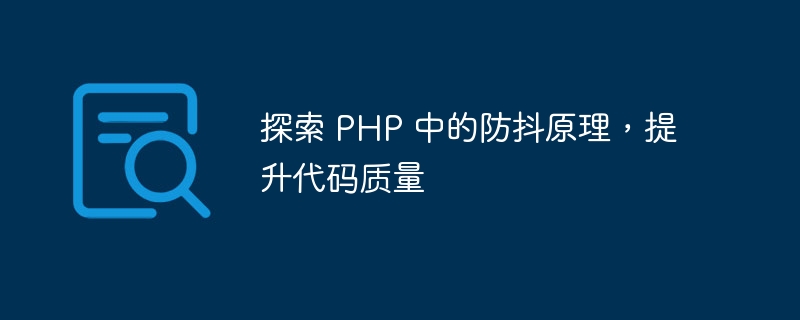
探索 PHP 中的防抖原理,提升代码质量,需要具体代码示例
防抖(Debounce)是一种常用的前端技术,可以防止在频繁触发事件时过多地执行相应的操作。然而,并不只有前端开发中才需要使用防抖,PHP 后端开发也可以借鉴这一原理来提升代码质量。
防抖的原理是,设置一个计时器,在指定的时间间隔内,如果连续触发事件,就会清除计时器重新开始计时,直到指定时间内没有触发事件,才会执行相应的操作。这样可以避免在短时间内频繁地执行代码,提高代码的执行效率。
在 PHP 中实现防抖的方法可以通过使用闭包和定时器来完成。下面是一个具体的示例代码:
立即学习“PHP免费学习笔记(深入)”;
function debounce(callable $callback, int $delay) {
$timerId = null;
return function() use ($callback, $delay, &$timerId) {
if ($timerId !== null) {
clearTimeout($timerId);
}
$timerId = setTimeout(function() use ($callback) {
$callback();
}, $delay);
};
}
function doSomething() {
// 执行相关操作
echo "执行操作" . PHP_EOL;
}
// 创建一个防抖函数,间隔时间为 1000ms
$debouncedFunc = debounce('doSomething', 1000);
// 模拟连续触发事件
for ($i = 0; $i < 10; $i++) {
$debouncedFunc();
usleep(200);
}在上面的示例代码中,我们创建了一个 debounce 函数,它接受一个可调用的函数和一个延迟时间作为参数。返回值是一个闭包函数,在闭包函数中处理了防抖逻辑。
在使用闭包函数时,我们维护了一个变量 $timerId ,用于记录定时器的 ID。在每次触发事件时,如果定时器已经存在,则清除之前的定时器,重新开始计时。然后,使用 setTimeout 函数来设置一个延迟执行的定时器,当延迟时间过后,执行传入的回调函数。
在实际应用中,我们可以将需要进行防抖的操作放在 doSomething 函数中,通过调用防抖函数 $debouncedFunc 来触发这些操作。通过使用防抖函数,即使连续触发多次操作,也只会在一定时间间隔后执行一次,从而减少不必要的计算和资源消耗。
总结一下,防抖技术不仅能够在前端进行频繁事件的优化处理,而且在 PHP 后端开发中也可以借鉴使用,以提升代码质量和执行效率。结合闭包和定时器,我们可以很方便地实现防抖功能,并通过具体的函数示例代码来演示其工作原理。在实际项目中,开发者可以根据具体的需求和场景,灵活运用防抖技术,优化代码的执行效率。
以上就是探索 PHP 中的防抖原理,提升代码质量的详细内容,更多请关注php中文网其它相关文章!

PHP怎么学习?PHP怎么入门?PHP在哪学?PHP怎么学才快?不用担心,这里为大家提供了PHP速学教程(入门到精通),有需要的小伙伴保存下载就能学习啦!

Copyright 2014-2025 //m.sbmmt.com/ All Rights Reserved | php.cn | 湘ICP备2023035733号